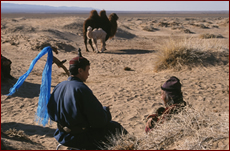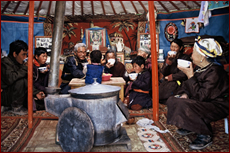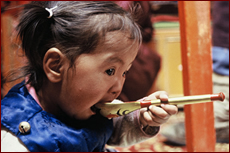The Mongolian Desert - Page 2
Religion and Festivals:

Mongolia is traditionally a Buddhist country, although the religion was repressed in the early 20th century when the country was ruled by Communists. Monks and priests were executed, exiled and imprisoned, and ordinary Mongolians were discouraged from practising their religion. Mongolia has gained more independence since 1990, allowing Buddhism to flourish again, with monasteries re-opening and people being able to worship freely. Other religions, such as Christianity and Islam have also been introduced since independence.
Every Buddhist home has a shrine, and there are also shrines dotted across the landscape for ceremonies such as Ovoo (see below). Mongolian people have a deep reverence for nature as well as their Buddhist faith. As we see near the beginning of The Story of the Weeping Camel, a traditional ritual that is still performed today is the splashing of fresh tea with milk into the air at dawn, as an offering to the sky and Mother Nature.
The main festival in the Mongolian calendar is Tsagaan Tsar, or White Month, which occurs around February every year. It is a celebration of the approaching Spring, and the start of the period when livestock produce milk. Families prepare for Tsagaan Tsar at least a month in advance, making lots of food and gifts, as the festival symbolises wealth and prosperity. The whole family home (gher) and all the animals’ pens and sheds are cleaned meticulously, and on the eve of the new year a special meal is cooked and eaten after the stars have come out. The next morning everyone rises early to watch the sun rise and take the ‘first steps of the new year’, which ensure your good health and happiness.
The ceremony that we see in The Story of the Weeping Camel is performed to honour nature – the people go to an Ovoo (a pile of stones raised on a hill or mountain top) with food and other offerings and voice words of praise to the spirit of the mountain and the surrounding area.
Storytelling:
Mongolia has a very rich tradition of folk tales, which deal with everyday issues such as herding livestock as well as epic stories of warriors. Originally passed down by word of mouth, many are now written down and have become well known parts of Mongolian culture.
Mealtimes:

At mealtimes, there are some parts of meat that are considered delicacies, and may be offered to guests as a special treat. They should be eaten and enjoyed to respect the Mongolian customs. Food or drink will be offered to a guest from the host’s right hand, and should be accepted by the right hand as well.
Houses:
For nomadic Mongolian people, who do not live in towns and cities, the traditional dwelling is called a gher. It is a round building made of a wooden frame and thick felt covering, which is easy to transport. There are 2 layers of felt, which is excellent protection against the cold in the winter and dries very well if it ever gets wet. The top of the gher is covered in a felt flap which is opened during the day or in good weather and covered up in storms.
When a gher is erected, the door is always facing the sun in the south. Sacred and valuable possessions are displayed on the wall opposite the door, which is the most honoured place in the house. According to tradition, the western side of the gher is the male quarters, where the husband keeps his saddle and horse bridle, and the eastern the female, where the wife keeps her kitchenware.
The fireplace or hearth is in the centre of the gher, where it is not only used for heating and cooking, but is also a symbolic link with the family’s ancestors. If the hearth is desecrated, perhaps by throwing water or rubbish into it, it is seen as an insult to the master of the house.
Food and Drink:

In summer and autumn, Mongolian people eat mostly milk products, whilst in winter and spring it is mostly meat. Flour and rice are eaten all year round. Beef and mutton are eaten most commonly, with chicken and fish generally only eaten by people living in the more modern cities. Meat is either stewed over the hearth, baked on hot stones or dried in the sun and wind so it can be stored for long periods of time.
Milk is used for a huge variety of dishes; first it is boiled and stirred until a thick skin can be removed, called urum. The boiled milk is then fermented and made into yogurt, sour cottage cheese (aarts) and a dry curd sweet (aaruul). Dairy products can be prepared and stored so that they are still available in the winter months when animals are no longer producing milk. Mongolians love tea and drink it with milk throughout the year, at any time of the day. Sometimes butter, milk and salt are added to make ‘flour tea’ which is very nourishing. Milk is even fermented into an alcoholic drink – airag. It is made by fermenting mare’s milk in a bag made of cow’s skin or a wooden vessel.
Family:

In traditional society, each married couple have their own gher. When a son gets married, he receives his share of the family herd. Daughters marry out to new families. In the last few decades, more herders’ children have left the traditional life to live in towns and work in skilled trades or administrative positions, leaving fewer to take over the family herds in the countryside. The elders in a family are the most respected and are usually greeted first and take the leading role in many rituals.
